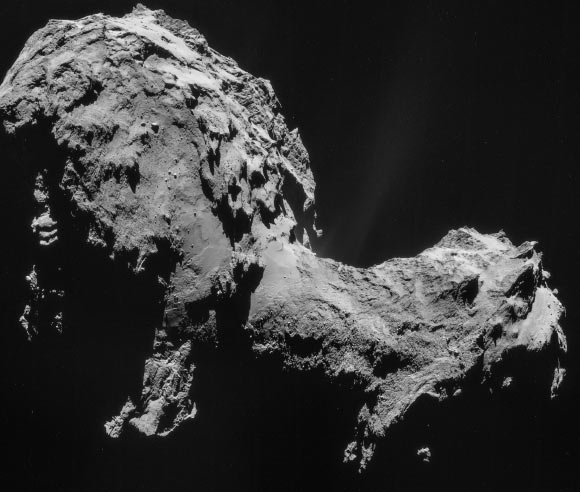The Rosetta Orbiter Spectrometer for Ion and Neutral Analysis (ROSINA) mass spectrometer aboard ESA’s Rosetta spacecraft has detected the noble gas argon, along with other gases, in the coma of 67P/Churyumov-Gerasimenko.

Mosaic of four images taken by Rosetta’s navigation camera on September 19, 2014, at 28.6 km from the center of 67P/Churyumov-Gerasimenko. The images used for this mosaic were taken in sequence as a 2×2 raster over a 20 minute period, meaning that there is some motion of the spacecraft and rotation of the comet between the images. Image credit: ESA / Rosetta / NAVCAM / CC BY-SA IGO 3.0.
The so-called noble gases rarely react chemically with other elements to form molecules, mostly remaining in a stable atomic state, representative of the environment around a young star in which planets, comets, and asteroids are born.
In addition, their abundance and isotopic compositions can be compared to the values known for Earth and Mars, and for the solar wind and meteorites.
The relative abundance of noble gases in the atmospheres of terrestrial planets is largely controlled by the early evolution of the planets, including outgassing via geological processes, atmospheric loss, and/or delivery by asteroid or cometary bombardment. Thus the study of noble gases in comets can also provide information on these processes.
However, noble gases are very easily lost from comets through sublimation, and so the detection of argon at 67P/Churyumov-Gerasimenko is a key discovery.
It’s for the first time that scientists were actually able to measure this particular gas on a comet.
Prof. Hans Balsiger of the University of Bern’s Physics Institute and his colleagues identified isotopes 36Ar and 38Ar, yielding an isotopic ratio for 36Ar/38Ar of 5.4, which is compatible with Solar System values: for Earth, this isotopic ratio is 5.3, while for the solar wind it is 5.5.
“Even though the argon signal is very low overall, this unambiguous first in-situ detection of a noble gas at the comet demonstrates the impressive sensitivity of our instrument (ROSINA),” said Prof. Kathrin Altwegg of the University of Bern.
The relative abundance of argon to other gases was also investigated.
“The argon-to-water ratio varied by more than a factor of 20,” Prof. Balsiger said. “While the very volatile argon can escape under any conditions, water sublimation depends strongly on the amount of sunlight being received, and so with it the argon-to-water ratio.”
He added: “the argon-to-water ratio on Earth is several magnitudes lower than observed at 67P/Churyumov-Gerasimenko.”
“If it were the same here on Earth as on the comet, we’d have far greater quantities of argon in our atmosphere.”
The researchers describe their findings in the September 25 issue of the journal Science Advances.
_____
Hans Balsiger et al. 2015. Detection of argon in the coma of comet 67P/Churyumov-Gerasimenko. Science Advances, vol. 1, no. 8; doi: 10.1126/sciadv.1500377







